Disclosure: Meeple Mountain received a free copy of this product in exchange for an honest, unbiased review. This review is not intended to be an endorsement.
As a big fan of Battlestar Galactica: The Boardgame, the temptation for me to open this review with a comparison of Mantis Falls to BSG is too strong. If you like traitor games but have been dismayed that they all require at least 3 players and benefit strongly with 4+ players, brighten up! The sun will shine through the dark nights of Mantis Falls as it successfully brings you all the suspense of a traitor game with as few as 2 players. However, the road out of Mantis Falls is a long, treacherous one, even for the traitor! Read on to learn more about Mantis Falls and how it manages to create uncertainty with only 2-3 players.
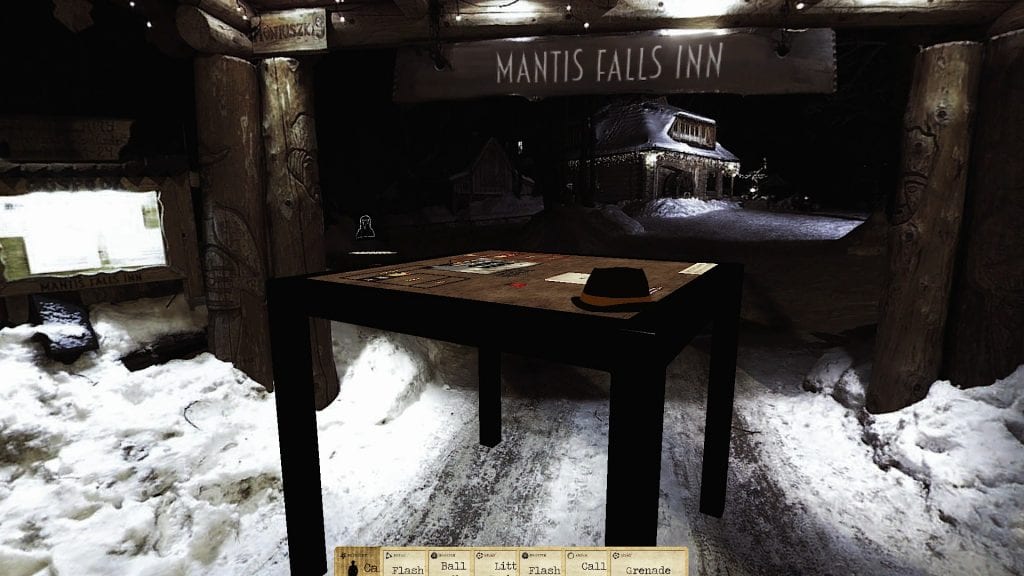
Theme
Mantis Falls is set in a fictional 1940’s mountain town ruled by the mob. The art and naming is supposed to evoke the feeling of a mystery show like Twin Peaks, and the manual actually recommends the Twin Peaks soundtrack as theme music. The artwork, naming conventions, and overall theme do a great job of drawing you into a general sense of dark foreboding, conspiracy, and twisted scheming. After several sessions of play, there’s really only one criticism I have about the theme: the choice to use “assassin” instead of “hitman” or “fixer” to be gender-neutral. For me, “assassin” sounds too exotic and feels like the wrong genre.
Gameplay
Objective
Thematically, at least one of you witnessed something you shouldn’t have seen and you’re trying to escape the town. You’ve been told that another witness is joining you. At the beginning of the game it is sunset, quickly approaching the dead of night.

The objective of the game depends on the role you are randomly assigned during setup. There are only two roles to be assigned, but there is always one more role card than players. So in any given two player game, there might be an Assassin and a Witness or there might be two Witnesses. To win as a Witness, you must begin a turn with all Witnesses at The End of the Road or have all Witnesses alive when the Assassin dies. To win as an Assassin, you must be alive when a Witness dies. If both Assassin and Witness die, it’s considered a tie game.
This system ensures that Witness players start out with uncertainty regarding how far to cooperate and trust. At some point during the game, a Witness will have to make a choice to trust based on their assessment of the other player.
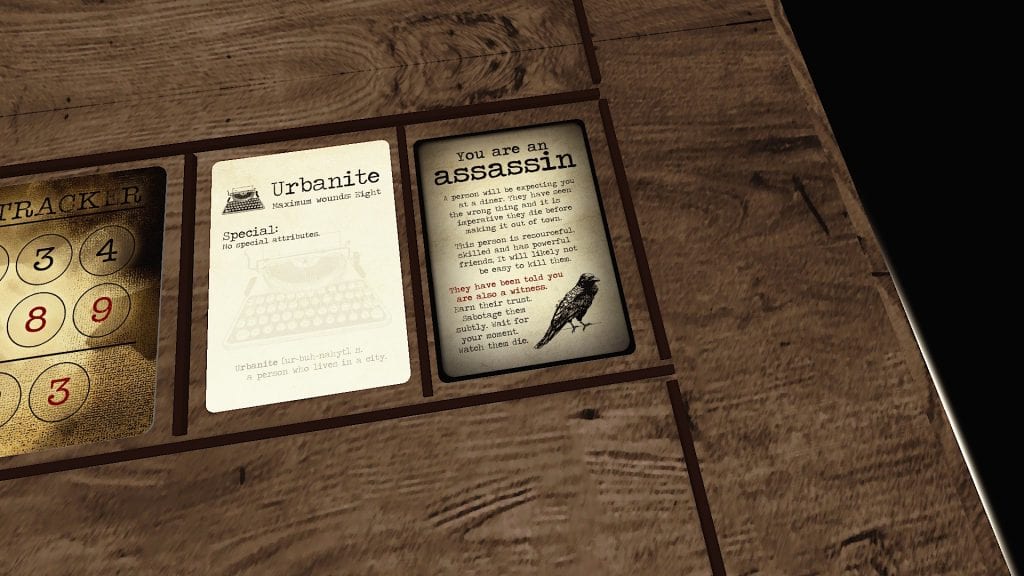
Setup
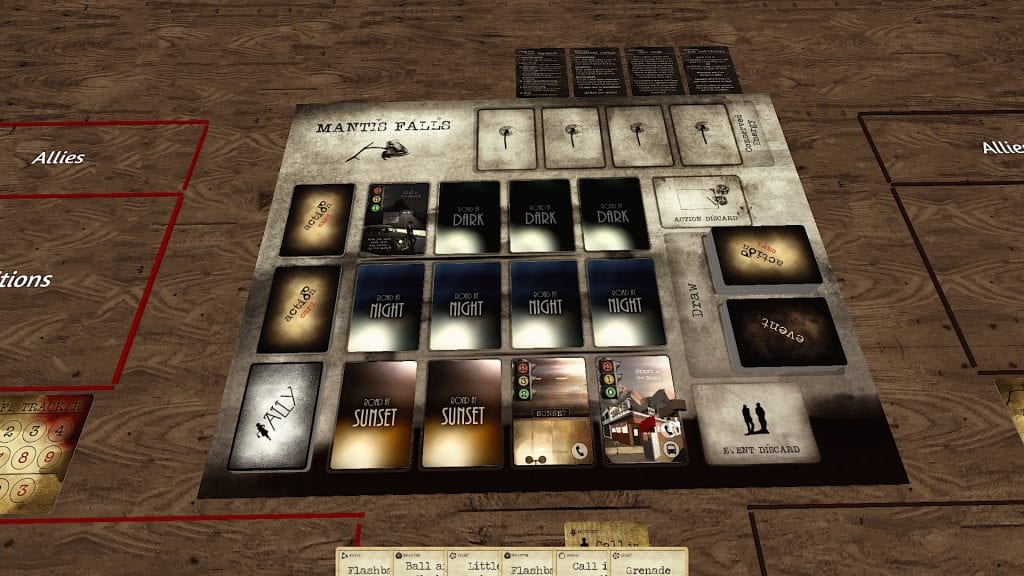
The players arrange the playing space by making a game board with 12 road cards in a 3×4 grid. The first row are the Sunset road cards, the second row are the Night road cards, and the final row consists of the Dark road cards. These road cards are placed face down initially, flipping only the Start of the Road, the next road, and the last End of the Road.
Players are each dealt a role card, a character card (which has both a special ability and a counter for tracking Wounds received over the course of the game), and a special Action card of a particular suit, Midnight. In a typical 2 player game, this Midnight card is “Call in a Hit,” a card that allows a witness player to knock out the other player if they are close enough to a phone.
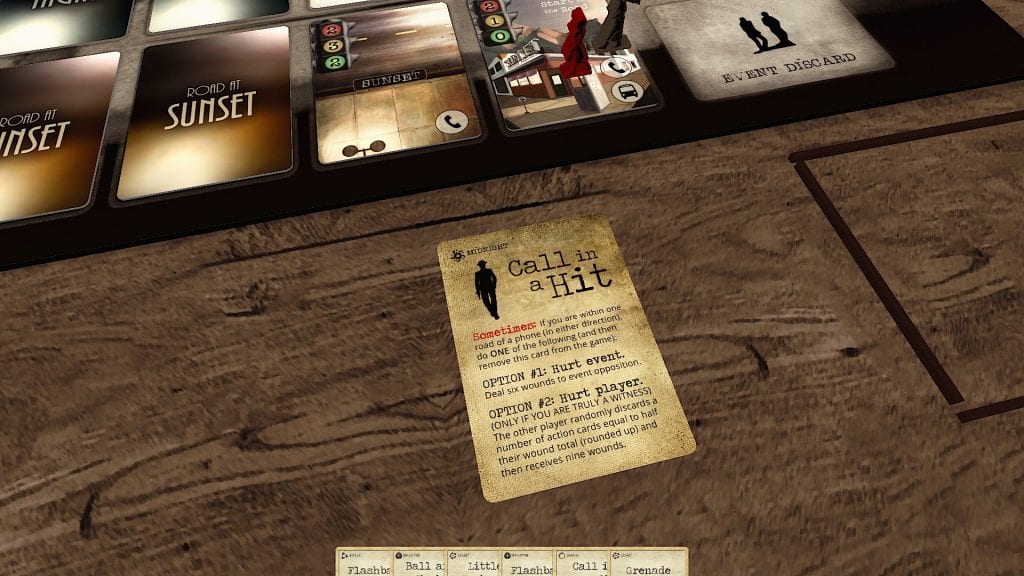
The remaining Midnight suit cards are split and placed next to the Night and Dark Road cards; the rest of the Action cards with their varied suits are placed on the other side of the Night road along with the Event deck leaving spaces for discards of both decks. There should also be space for 4 cards above the board for Conserved Energy.
Play
Here’s a rough description of how play works, as there’s really no better substitute for going through the instructions and walking through the game a few times to get all the nuance down. The players alternate turns. Each turn, the current player may move ahead one road space. They may also use the shared Conserved Energy cards (if any are available) to gain more movement or heal their Wounds. Players traverse the Road in a serpentine pattern from Sunset to Night to Dark. Players flip Road cards one space ahead of the most advanced player’s piece so that players may always see at least one space ahead.

Then the current player draws an event card to their hand. These Event cards typically either immediately harm the players or threaten to harm the players if the players cannot prevent it. Each event card has a type: either Seen or Unseen. The player must reveal it if it is a Seen type event or keep it in their hand if it is an Unseen type. A player may say whatever they like about the Unseen event, but may never actually show the card and must actually follow the rules of the card during Event processing which occurs after the Main play phase.
During the Main play phase, each player, with the current player going first, chooses one of four options:
- Place action cards of the same suit (Amber, Granite, Hunter, Lilac, Royal, or Midnight) face down in the play area
- Place a single action card in the Conserved Energy stockpile
- Discard up to two action cards
- Do nothing.
The Action Reveal/Processing phase follows where any action cards in the play area are flipped and then processed. These are revealed in an alternating fashion, one card of the current player and one of the other, going back and forth until there are no cards left unrevealed or a player is dead.
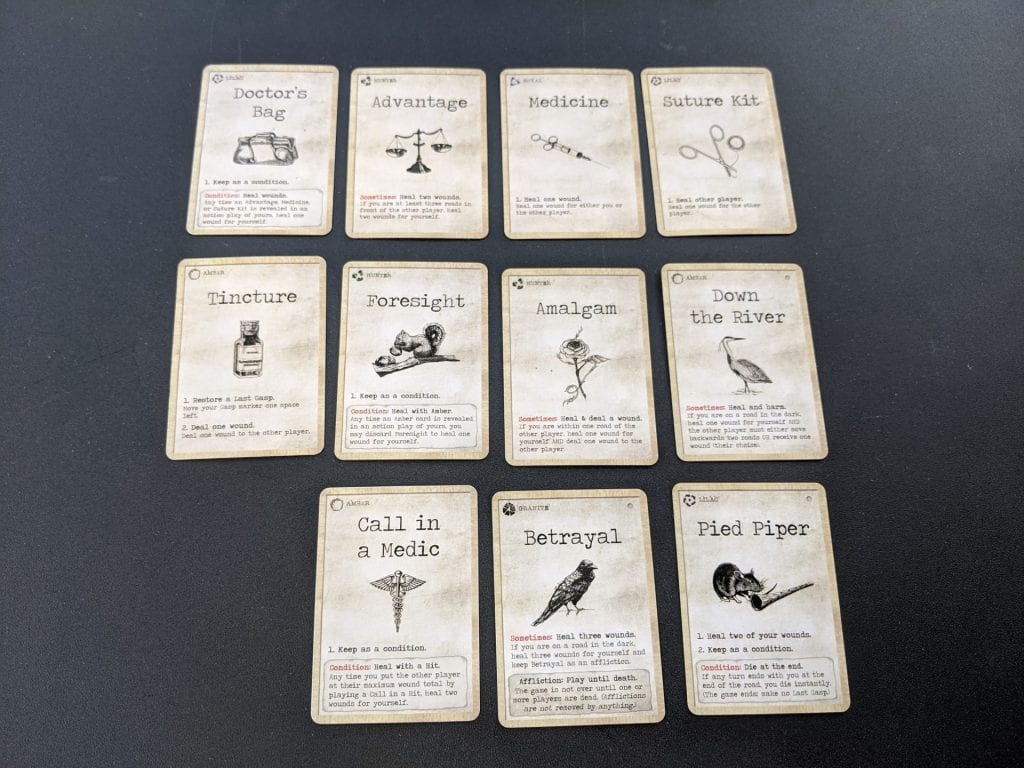
Next is the Event Processing phase where the previously drawn Event is actually processed. Sometimes, the effects of Action Processing have negated the harmful possibilities of the Event or have neutralized it completely. Sometimes there are positive bonuses for successfully defeating an Event.
Finally, starting with the current player, each player restores their hands to seven cards by drawing from some combination of the draw pile or the Conserved Energy stockpile. Now on to the beginning of the next player’s turn. If all players are at the End of the Road and alive, it’s time to check their Role to determine victory; the Witnesses have won.
There’s another phase called the Last Gasp. It occurs whenever a player reaches their maximum Wounds, which can be anywhere from 7-9 Wound capacity depending on their character. Regular gameplay is paused and that player is given the opportunity to escape death. A player may play any number of same suited cards in a separate sidebar action play just like in the first option during the Main play phase. Players may reduce their Wounds and continue the game or they may just kill off the other player too! Last Gasps have a limit tracked by a Last Gasp marker; players still die and lose if their Gasp marker reaches and stays on 3. If the game has not ended, play continues from where it left off prior to the Last Gasp.
At any point, once a player is dead, the game ends for all and Roles are checked to determine who won, lost, or tied.
The General Dynamic
Now, to really get a feel for the game short of actually playing, here are a few more details. There is a constant tension of the witness(es) trying to ferret out a clue about the true loyalty of the other players while trying to successfully reach the End of the Road. A witness must survive various Events, which consist mostly of cards that will cause Wounds, to reach the End of the Road. However, it’s not enough for one player to reach The End of the Road. If all players are witnesses, then they must all reach the End of the Road alive. So, do you help the other player or save your cards for yourself?
Additionally, there’s a Broken Road that may appear in the middle of the Road in the Night row. If it is there, it takes a special coordination of extra movement to make it past into an unknown Road space because you may not stay on the Broken Road and thus the Road beyond remains unflipped until the Broken Road is crossed. However, successfully crossing the Broken Road gains first choice access to the more powerful Midnight suited Action cards next to the Night row. Same for reaching the End of the Road: whenever a player first lands there, they get to choose one of the Midnight suited Action cards next to the End of the Road. These cards allow for some very powerful maneuvers if played correctly.

So, where is the tension for Assassins? Why don’t they just kill the Witness(es) as soon as possible instead of pretending to be a Witness? The special Midnight suited card, “Call in a Hit.” This card allows both players to deal six Wounds to an event. This can be a life saver, especially early on. But only a Witness can use its true power, the power to hurt another player, forcing that player to lose half their cards and suffer maximum Wound damage–with only one caveat, they must be within one space of a Road containing a Phone icon. So the moment an Assassin reveals, Witnesses can go on a devastating attack. Assassins must be extra careful while a Witness is near a phone. This card can even be used during a Last Gasp, so if a Witness knows they will not survive, they have no reason not to use the card and at least tie the game.
Of course, if a Witness falsely convinces themselves that a player is an Assassin rather than a Witness, calling in a hit can cause mutual loss. If the other player manages to survive through the Last Gasp, they will have proved that they are a Witness.
There are a lot of other interesting effects among the Action cards, too many to list here. Most have a way of adding to the tension or tactics. Additionally, there are add-on Modules that aid in fighting any monotony that may develop from playing the base game.
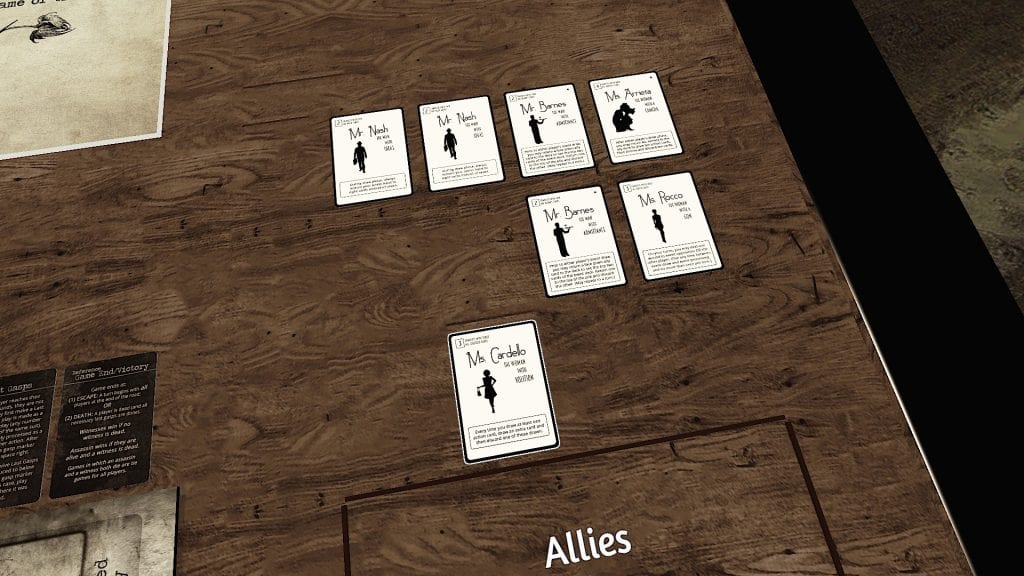
Analysis and Thoughts
In the era of modern board games that we’re in, it isn’t really a question of whether a game is good. It’s a question of whether this game is good for a particular audience looking for a new game where there are often hundreds of great choices. After spending some time with it, I believe this is a good game for some audiences described below.
If you like Twin Peaks or mobster-like stories and atmosphere, you can really get into this game. The theme here is strong.
If you’re a fan of traitor games and looking for a 2 player version, you’ll enjoy this game as long as you are willing to accept one glaring weakness: game balance. It’s not that the game favors Assassins or Witnesses; it favors itself. The game and its Events are far more likely to kill a player, especially in the early game, than either player is. In one game I had, the Assassin won not because he did anything smart or made any choice towards killing the Witness, but because the game was so brutally efficient in killing off the Witness (and would have killed the Assassin in another turn or two). The game has the capacity to kill a player even with both players doing everything they can to help each other.
However, I think that game balance here is only a weakness, not a game breaking flaw. I compare Mantis Falls to a game of traditional solitaire. Some games are winnable, some are not. You still play because you’ll still have fun in the attempt and you don’t usually know until you try. It’s the journey of the game that occupies your time and makes the game fun; winning is an additional reward. Sometimes, Mantis Falls is stacked against the players. As your experience with it grows, I believe that the better player may win by making sure they are the player that survives one more turn, but there will inevitably be some sessions where nothing a player chose could make a difference. If you’re looking for a game where the better player ALWAYS wins, this is not the game for you.
Overlook the occasionally skewed game, and the room for tension is enormous. The tension created by interplay of the various Actions cards, the Road, and the secrecy is the best reason to play and enjoy Mantis Falls.


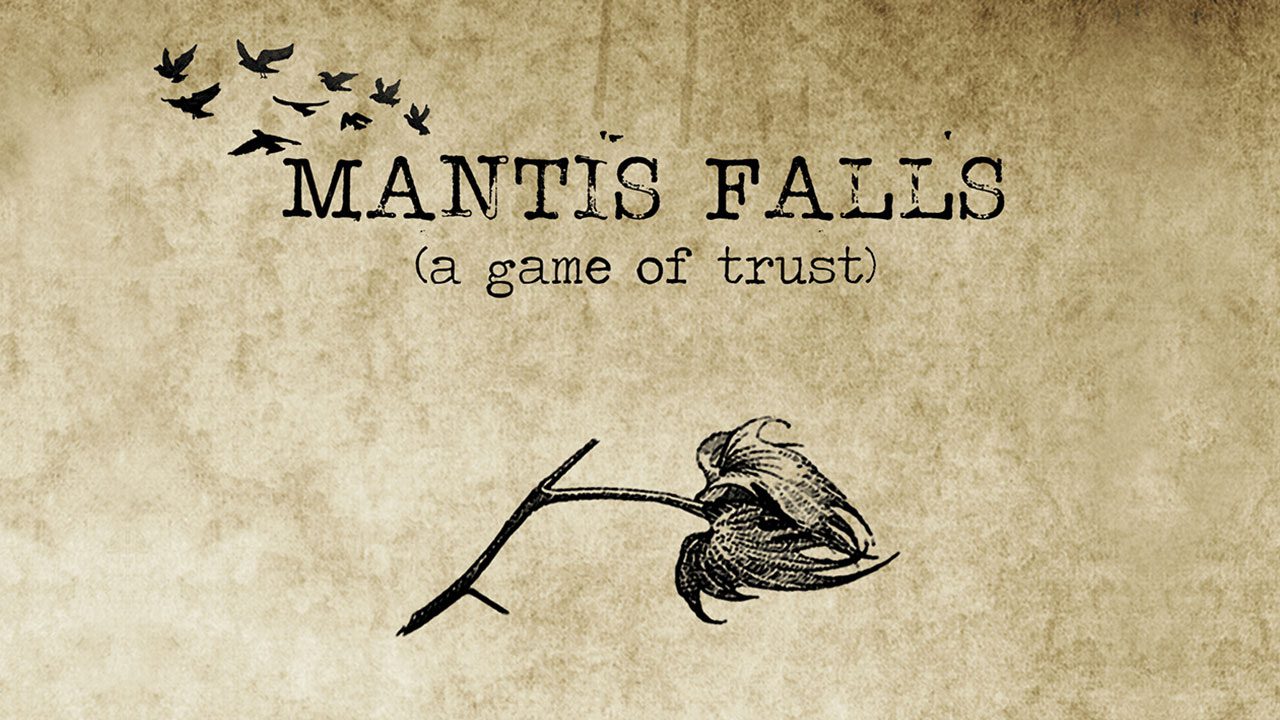




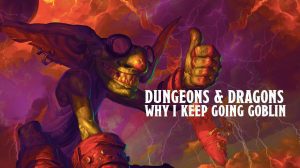




Great review!
Are you aware that a Spanish website has copied and translated into Spanish word by word your review without quoting you?
You can check it, maybe google trasnlate can help. I can assure that it is literal translation:
https://jugondemesa.com/resena-del-juego-mantis-falls/
Cheers!
Muchas gracias Jose! We’ll contact their hosting company and see if we can get that stolen content taken down.